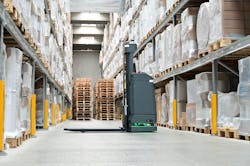- 72% of manufacturers using AI to reduce costs and improve operational efficiency, though adoption in operational technology remains more cautious than in enterprise IT.
- Four critical use cases are emerging as AI game-changers: Predictive maintenance is using machine learning to detect equipment failures before they occur, quality control is leveraging machine vision for faster defect detection, robotics are handling more variable tasks through AI-enabled adaptability, and energy management systems are optimizing plant operations to achieve significant cost savings.
- The greatest impact occurs when AI technologies work together across multiple systems, combining quality data with energy data, predictive maintenance insights and supply chain information to enable multilevel optimization and autonomous decision-making that goes beyond what isolated AI applications can achieve.
AI may be the dominant force in enterprise IT deployments, but the technology is being more cautiously applied to industrial digital transformation as part of a slow, but steady evolution from automation to autonomy.
As with most sectors, manufacturers are captivated by all forms of AI, including machine learning, generative AI (gen AI) and, more recently, agentic AI. According to a National Association of Manufacturers (NAM) Manufacturing survey, manufacturers are starting to tap AI to reduce costs and improve operational efficiencies (72%), bolster operational visibility and responsiveness (51%) and uplevel process optimization and controls (41%).
Furthermore, 22% of survey respondents showed interest in AI to shore up quality capabilities, while 19% saw value in the technology for improving asset reliability.
“It’s definitely not a moon shot any more. People are beginning to recognize the value [of AI],” said Rahul Garg, vice president of industrial machinery at Siemens Digital Industries Software. “We are seeing people start to use AI to enhance production and operator tasks, for programming, design and scheduling, and to improve quality. Leveraging AI to improve productivity of existing operations is the easy step on this journey. The next leap is using the technologies to reimagine how to do things.”
Of course, manufacturers are no strangers to AI. AI models and machine learning have been part of the industrial automation landscape for some time through its use in quality control inspections, robotics and maintenance applications. Gen AI and agentic AI are far less mature and are just starting to find a home in industrial applications, mostly to enhance operator productivity, automate reporting and aid in adaptive planning.
In emerging cases, gen AI and agentic AI technologies are working in tandem to push automation processes to the next level.
Take anomaly detection, for example. “Machine learning (ML) provides the analytics functions, and gen AI delivers diagnostic reasoning that typically requires some level of human input,” explained Rick Kephart, vice president of technology for Emerson’s power and water business.
For the moment, however, gen AI is far less entrenched for OT applications than in IT because the constraints — and the stakes — are so much higher. “In production power generation, for example, there are stringent cybersecurity and compliance rules, so the maturity of gen AI is not as advanced as it is in enterprise IT environments,” Kephart added.
AI moves the needle for key use cases
Nevertheless, AI/ML and gen AI are already beginning to reshape critical industrial use cases across the plant floor and in field operations. Here is a look at how four critical areas are shaping up:
Predictive maintenance. This is one of the marquee use cases for AI-powered innovation. Machine data collected from Industrial Internet of Things (IIoT) sensors is coupled with AI/ML analytics to proactively detect and resolve potential asset problems prior to a failure, minimizing downtime and reducing maintenance costs. AI is the gamechanger for predictive insights and anomaly detection because it boosts the quality of insights by delivering more diagnostics insights and doesn’t always require a human operator to interpret results to manually initiate a resolution.
In addition, instead of limiting predictive maintenance to well-categorized, known issues, AI opens up the possibility of solving non-standard problems. That, coupled with AI’s capacity for adaptive learning, makes predictive maintenance practices even more valuable.
Flexibility is achievable via modular hardware and reconfigurable software. Many industrial controllers use a modular backplane, allowing adding or swapping I/O modules to support new sensors or actuators without a complete system overhaul.
“Problem resolution is far more effective when AI is inferencing past learnings to generate new ideas,” Garg explained. He sees the potential for agentic AI to enhance Senseye, Siemens’ predictive maintenance platform, to notify service technicians of an issue, create a resolution and automate a correction with or without human operator approval, depending on the desired workflow.
Predictive maintenance AI models built on the right operating conditions can also help with talent constraints as manufacturers struggle to find new operators as an aging workforce retires.
“You can capture the knowledge of experts as part of these platforms,” said Karthik Gopalakrishnan, solutions consultant for Yokogawa, referring to its OpreX Asset Performance Monitoring and Predictive Maintenance platform. “Customers in different regions might operate equipment differently. This captures what site A is doing and how they are fixing issues so sites B and C can learn from them.”
In one example of AI-fueled predictive maintenance improving operations, a mining company has improved its worker safety through the ability to accurately predict equipment failures on its ventilation systems in the field. Here, Rockwell Automation’s FactoryTalk Analytics GuardianAI taps into data from its PowerFlex drives used to power ventilation system fans to proactively identify anomalies and alert maintenance teams to correct the problem. Since its implementation, the mining firm has avoided unplanned downtime by detecting fan blade alignment issues to increase the safety of miners in the field.
Quality control and inspection. Machine learning and machine vision can detect defects and identify anomalies much faster and more accurately than human inspection through real-time analysis of images and sensor data. AI model training for these use cases is highly visual, making it far more accessible and easier for manufacturers to get started.
By continuously analyzing real-world signals, physical AI is capable of detecting product defects and process deviations the moment they occur. It can automatically trigger interventions or adjustments before issues impact output.
Beckhoff is making a play in this area with its TwinCAT 3 Machine Learning Creator, a graphical, no-code, Web-based development platform that lets users create AI models without any AI development expertise. Users simply feed images labeled with “good part” or “bad part” into the platform and the system performs inferencing in real time while automatically generating a ready-to-run machine vision project.
“You can classify different images without a programmatic approach or having to manually sift through a bunch of data, which makes it easier for customers to conceptualize and implement,” said Brandon Stiffler, U.S. software product manager for the TwinCAT automation tool platform at Beckhoff.
AI is also moving the needle on quality inspection applications with robotics. 3D Infotech, a maker of automated industrial metrology solutions, developed an AI-driven inspection system integrated with Universal Robot’s AI Accelerator, a hardware and software robotics platform for developing AI applications for cobots. The addition of AI drives adaptability in the quality inspection platform, optimizing robot movement for varying inspection scenarios, enabling real-time obstacle detection for seamless operations, and automating decision making through enhanced defect detection and visual feedback.
Robotics. While robotic systems have been front and center in manufacturing automation for decades, the rise of AI creates an inflection point for the ability of robots to accomplish more complex tasks that were historically seen as being too difficult. That’s why, to date, most robotics deployments are centered around fixed automation — for example, to run a welding tool in an automotive plant, which is a high-precision, low-variance task.
Automation also enables process visibility across systems, connecting signals from different parts of the factory so teams can see how a small change in one phase might affect quality downstream.
AI becomes a key enabler when there is variability or a semi-structured environment, noted James Davidson, chief AI officer at Teradyne, the parent company of Universal Robots and Mobile Industrial Robots (MiR). “AI helps robotics expand into applications with variability — areas where there is high changeover and you need something adapted quickly,” he explained.
MiR’s Pallet Jack, for example, uses AI-based perception for fast and precise pallet detection and to minimize pick-and place cycle times. Historically, automated pallet jacks used 2D LiDAR, which could only detect a handful of pallet types. “It didn’t cover enough use cases to have value to customers and deliver ROI,” Davidson said. The AI-perception system helps address those shortcomings, enabling the system to accurately detect pallets regardless of color variations or broken components — even if the pallets are shrink-wrapped.
Energy management. Asset data and AI-fueled analytics are helping to optimize energy use by plant floor machinery or HVAC infrastructure.
At a machine level, AI can help optimize a motion profile, so that a machine uses less energy and experiences less wear and tear. At the plant level, AI-powered optimization processes can be tied into an entire plant’s operations, including into production planning and scheduling systems to minimize run time and waste.
“Once we have an AI model or agent tied into the whole business system instead of individual equipment, you can see greater results,” said Stiffler. Using AI for energy optimization was the focus of Rockwell Automation’s co-innovation project with a global semiconductor company looking to reduce energy consumption of a chiller plant in its fabrication site. As part of a co-inovation agreement, Rockwel Automation deployed an energy optimization system for predictive, multi-objective optimization of plant operations.
Using a digital twin of the chiller plant’s assets along with system modeling capabilities, the system supervises real-time system behaviors and operations to identify energy savings that will result in lower electricity bills. So far, the implementation has resulted in 5% improvement in plant efficiency during peak demand season and a projected savings of between $3 million and $5 million across multiple facilities, achieving ROI in less than two years, said Alexandra Farley, AI commercial enablement manager at Rockwell Automation.
Speaking about the application AI in industry beyond targeted applications, Farley said: “It’s not just one AI technology itself, but how it comes together in a role of agents and multilevel optimization. It’s when you can pull in quality data with energy data with predictive maintenance insights and supply chain data — that’s the tipping point.”
About the Author
Beth Stackpole, contributing writer
Contributing Editor, Automation World

Leaders relevant to this article:



